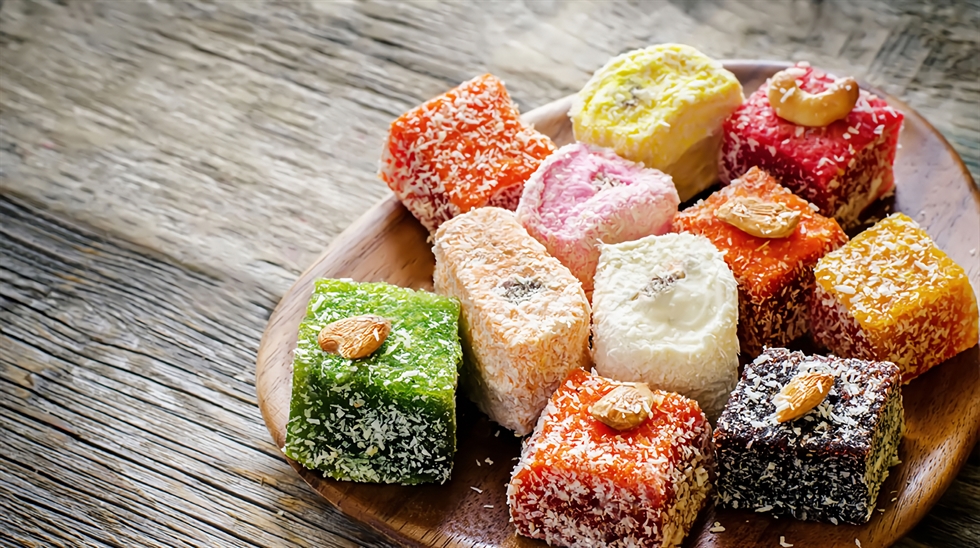Turkish Baklava
Baklava is a traditional Turkish pastry made from layers of phyllo dough filled with chopped nuts and sweetened with syrup or honey. The origins of baklava can be traced back to the Ottoman Empire, but it is also enjoyed in many other Middle Eastern and Mediterranean countries.
The traditional recipe for baklava calls for using a combination of chopped nuts, such as pistachios or walnuts, and a sweet syrup or honey to sweeten the pastry. The phyllo dough is layered with butter or oil between the layers to give it a flaky texture. The baklava is then baked until it is golden brown and crispy.
Baklava can be served as a dessert on its own or with a cup of Turkish coffee or tea. Some people like to sprinkle the baklava with cinnamon or other spices before serving, to add an extra layer of flavor. Some Variation in the recipe may include different nuts like hazelnut, almonds or even mixed nuts.
It is a very common dessert in Turkey, and you can find it in almost every pastry shop and cafe. Baklava is also served during special occasions like weddings, Eid al-Fitr, and Ramadan.
Baklava is delicious, rich and sweet, not to mention it’s a staple of Turkish Cuisine and culture, a must-try for those visiting Turkey.
Avuk Gogsu
Avuk Gogsu is a traditional Turkish dessert made from semolina and sugar. Its name literally means “groom’s pudding,” as it is often served at weddings and other special occasions.
The dessert is made by simmering semolina in milk and sugar until it thickens into a pudding-like consistency. It is then flavored with vanilla or cinnamon, and sometimes lemon zest is added too, to give it a subtle citrus taste. The pudding is then garnished with nuts, typically pistachios or almonds.
Avuk Gogsu is similar to other semolina-based puddings like Italian ricotta-based dessert called “cannoli” and Greek dessert called “halva”.
Avuk Gogsu is usually served chilled and is considered a comforting and satisfying dessert. It is a perfect dessert to end a rich meal or to have a sweet treat.
It is not as well-known or common as other Turkish desserts such as baklava or lokum, but it can still be found in some Turkish restaurants and dessert shops. Also, it may vary from regions to regions in terms of recipe, ingredients, and presentation.
Firin Sutlac
“Firin Sutlac” is Turkish for “oven rice pudding.” It is a traditional sweet dish that is typically made by simmering milk, sugar, and rice together in an oven until the mixture thickens and the rice is cooked through. The pudding is often flavored with ingredients such as vanilla, cinnamon, or lemon zest, and it is typically served as a dessert. Some variations also include ingredients like raisins, nuts, or dried fruits.
Kunefe
Kunefe (also spelled knafeh or kunafah) is a traditional Middle Eastern sweet dish made with shredded phyllo dough, known as “kadayif” in Turkish. It is a popular dessert in countries such as Turkey, Lebanon, Palestine, Jordan, and Egypt.
The dish is typically made by layering the kadayif dough with a sweet filling, such as cheese or sweetened nuts. The most common filling is a soft cheese called “kashkaval” or “akawwi,” which is similar to a mild and salty feta cheese.
Turkish Delights
Turkish Delight, also known as “lokum” in Turkish, is a type of confectionery that is popular in Turkey and throughout the Middle East. It is a gel-like candy that is typically made by simmering sugar, cornstarch, and water together, and then flavoring the mixture with ingredients such as fruit juice, nuts, or spices.
The traditional flavors are usually rosewater, mastic and lemon but today’s varieties expand from classical flavors to chocolate, hazelnut, pistachio and more. The candy is usually cut into small squares or rectangles and dusted with powdered sugar to prevent them from sticking together.
Kazandibi
Kazandibi (also known as kazandibi tatlısı in Turkish) is a traditional Turkish dessert that literally translates to “bottom of the pot.” It is made by simmering a milk-based pudding for a long time until it forms a thick, caramelized crust on the bottom of the pot. This crust is then inverted and served as the top of the dessert.
The pudding is typically made with ingredients such as milk, sugar, rice flour, and eggs. It is flavored with ingredients such as vanilla or cinnamon, and it is typically garnished with ingredients such as chopped pistachios or cinnamon.
Tulumba
Tulumba (also spelled Tulumbe or Tulumppa) is a traditional Turkish dessert that is made by deep-frying a batter made from flour, semolina, and yogurt, and then soaking the fried dough in a sweet syrup. It is a popular dessert that is enjoyed throughout Turkey, and it is also common in countries such as Greece and Cyprus.
The syrup used in tulumba can vary according to personal taste, some use simple syrup others use syrups flavored with rosewater, orange blossom water or mastic. The dessert can be served on its own or with a sprinkle of chopped pistachios or walnuts for garnish.
Pismaniye
Pismaniye (also spelled Pishmaniye or Pishmak) is a traditional Turkish sweet made with fine, twisted thread-like strands of dough, similar in texture to cotton candy, that is made by spinning fine dough and then deep-frying it. It is a very sweet and light dessert, often enjoyed as a treat after a meal, as a snack or as a souvenir to take back home.
It is similar to other sweets like fairy floss, and it is made by spinning sugar, corn starch, and oil together at high speed, which forms long thin threads of candy. The dough is then fried in hot oil until it puffs up and turns golden brown.
Ashure
Ashure (also spelled Ashura or Noah’s Pudding) is a traditional Turkish dessert that is typically made during the month of Muharram and served on the tenth day, known as Ashura Day. It is a sweet porridge-like dish that is made with a combination of grains, fruits, nuts, and sweeteners. The ingredients used in the pudding vary depending on regional and personal preferences, but typically include ingredients such as wheat, barley, lentils, chickpeas, dried fruits, nuts, and sweeteners such as honey, molasses, or sugar.
Ashure has a symbolic meaning, it is believed to have been first made by Prophet Noah after the flood, when he and his family were in shortage of food, it is thus called Noah’s Pudding.
Zerde
Zerde is a traditional Turkish dessert that is similar to rice pudding, but is made with a yellow-colored rice called “zerdali” and saffron. It is sweetened with sugar, and typically flavored with ingredients such as rosewater or orange blossom water. Zerde is a very popular dessert in Turkey, particularly in the Western and South-western regions of the country.
The most notable feature of Zerde is the vibrant yellow color that comes from using saffron, the most expensive spice in the world. This special spice gives a unique taste, aroma and visual appeal to the dessert.
Cezerye
Cezerye (also spelled Jazerye) is a traditional Turkish sweet made from carrot and sometimes with walnuts in it. It is a type of candy that is typically made by boiling carrots, sugar and other ingredients together until they reduce to a thick, sticky consistency. The mixture is then formed into small balls or blocks and coated with a thick layer of sugar syrup. Some varieties have additional ingredients like nuts, coconut, and chocolate to make them more rich.
This sweet is quite popular in the Mediterranean region of Turkey and it is especially known as a sweet coming from Antakya. It is traditionally served as a dessert, but it is also often enjoyed as a snack.
Gullac
Gullac (also spelled Güllaç) is a traditional Turkish dessert that is made from thin, translucent sheets of dough called “gullac yufkası” and typically filled with sweetened milk or cream. The dessert is often compared to baklava, and it’s originates from Central Anatolia. It is a very delicate and sweet dessert that is typically served during special occasions such as Ramadan, Eid al-Fitr, and weddings.
Katmer
Katmer (also spelled Katmer or Qatmer) is a traditional Turkish sweet pastry, similar to baklava, that originates from the city of Gaziantep in Southeast Turkey. It is made with very thin layers of phyllo dough and typically filled with a mixture of clotted cream and pistachios. The phyllo layers are brushed with butter and then rolled and shaped into a spiral before baking.
The dough for katmer is made in a similar way to baklava dough, and like baklava, it is also a rich and sweet pastry. The clotted cream and pistachios filling gives a unique taste and texture and make it a beloved pastry among Turkish people.
Ayva tatlisi (quince dessert)
Ayva Tatlisi (also known as Ayva Dolmasi) is a traditional Turkish dessert made with quince fruit. Quince is a fruit that is similar in appearance to a pear and it has a hard and gritty texture, but when cooked, it turns a beautiful shade of pink and has a unique, sweet-tart flavor.
The traditional recipe for Ayva Tatlisi involves simmering the quince in a sugar syrup with spices such as cinnamon and cloves. The quince is typically peeled, cored and then cooked in the syrup until it becomes soft and translucent.
Cevizli Sucuk
Cevizli Sucuk (also spelled Jevizli Sucuk) is a traditional Turkish sweet made with walnuts and syrup. It is a type of candy that is typically made by combining ground walnuts, sugar and other ingredients together, then shaping the mixture into sausage-like rolls. This sweet is popular in the Black sea region of Turkey, and it is a traditional sweet.
The texture of the sweet is quite different from traditional sausages and the taste is also unique because of the nuts and syrup. It has a crunchy outside and a chewy inside with a sweet, nutty flavor. It can be enjoyed on its own or used as a garnish for desserts like ice cream or puddings.




